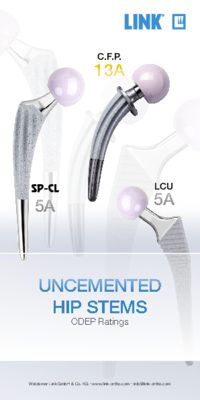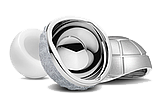At a glance
- Minimal bone resection by preserving the femoral neck
- Anatomical stem shape and integral anteversion
- Collar allows physiologic compressive forces to be transmitted back into the femur 1, 2
- 98.3% survival rate after 11 years3


Physiological force transmission
Two different stem curvatures allow adaptation to the individual patient’s anatomy - for extended support of the implant on the Shenton’s line. The successful ribbed structure provides secure, rotationally stable fixation in the compressed cancellous bone.4, 5
Femoral neck-preserving, bioharmonic hip prosthesis
The C.F.P. Hip Prosthesis Stem enables femoral neck-preserving, cementless implantation. It was developed specifically for young, active patients, whose long life expectancy means that they are more likely than older patients to experience aseptic loosening with a conventional hip prosthesis.
The design of the C.F.P. Hip Prosthesis Stem incorporates biomechanical loading and anchoring principles, conforming to the hip anatomy and physiology. This ensures stable, stress-resistant anchoring of the prosthesis.3
The bone-preserving resection, preserving the femoral neck, creates favorable conditions for later interventions.

Reduced stress shielding
The pronounced ribbed profile and the LINK Tilastan alloy give the stem a high level of structural and material-based elasticity compared to other hip systems. This in turn minimizes femoral stiffness, thereby reducing “stress shielding”.6
Successful long-term outcomes
Many long-term outcomes with survival rates of up to 98.3 percent after 11 years emphasize the success and great reliability of the C.F.P. stem.3
Related products
All productsSources
- Prendergast, P., & Taylor, D. (1990). Stress analysis of the proximo-medial femur after total hip replacement. Journal of Biomedical Science, 12(5), pp. 379-382.
- Keaveny, T., & Bartel, D. (1993). Effects of porous coating and collar support on early load transfer for a cementless hip prosthesis. Journal of Biomechanics, 26(10), pp. 1205-1216.
- Kendoff, D., Citak, M., Egidy, C., O'Loughlin, P., & Gehrke, T. (2013). Eleven-year results of the anatomic coated CFP stem in primary total hip arthroplasty. The Journal of Arthroplasty, 28(6), pp. 1047-1051.
- Noble, P., Alexander, J., Lindahl, L., Yew, D., Granberry, W., & Tullos, H. (1988). The anatomic basis of femoral component design. Clinical Orthopaedics and Related Research(235), pp. 148-165.
- Denaro, V., & Fornasier, V. (2000). Fill, fit and conformation - an anatomical and morphometric study of a hip component in total hip arthroplasty (Rippen-Link). European Journal of Orthopaedic Surgery & Traumatology, 10(4), pp. 239-247.
- Langhans, M., Hofman, D., Ecke, H., & Nietert, M. (1992). Der Einfluß der Formgebung des Prothesenschaftes auf die Beanspruchung des proximalen Femurs. Unfallchirurgie, 18(5), pp. 266-273.







